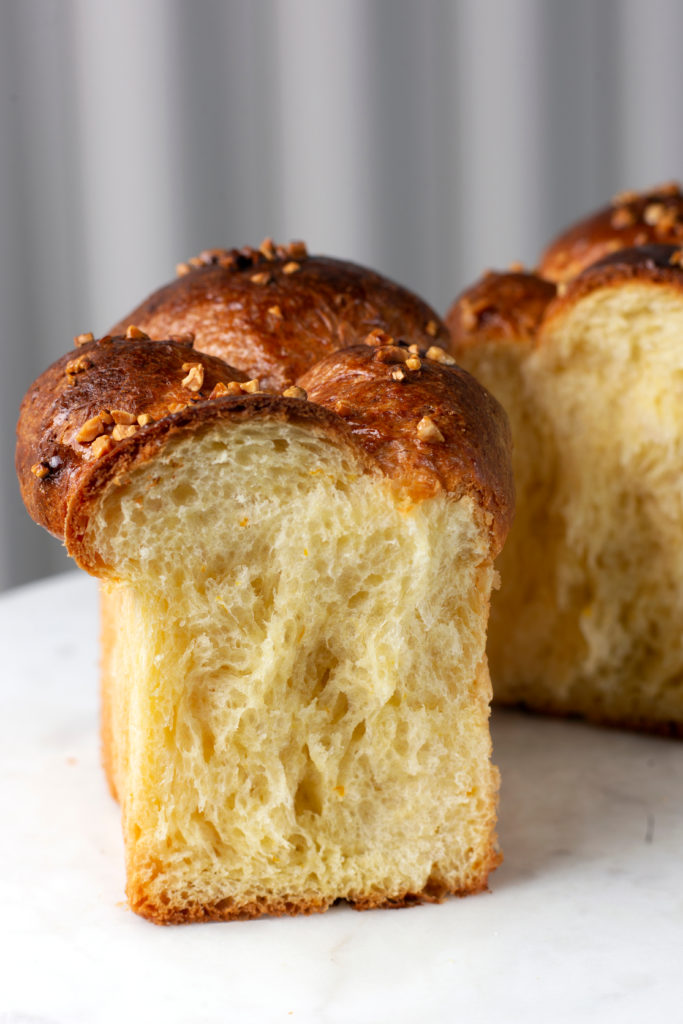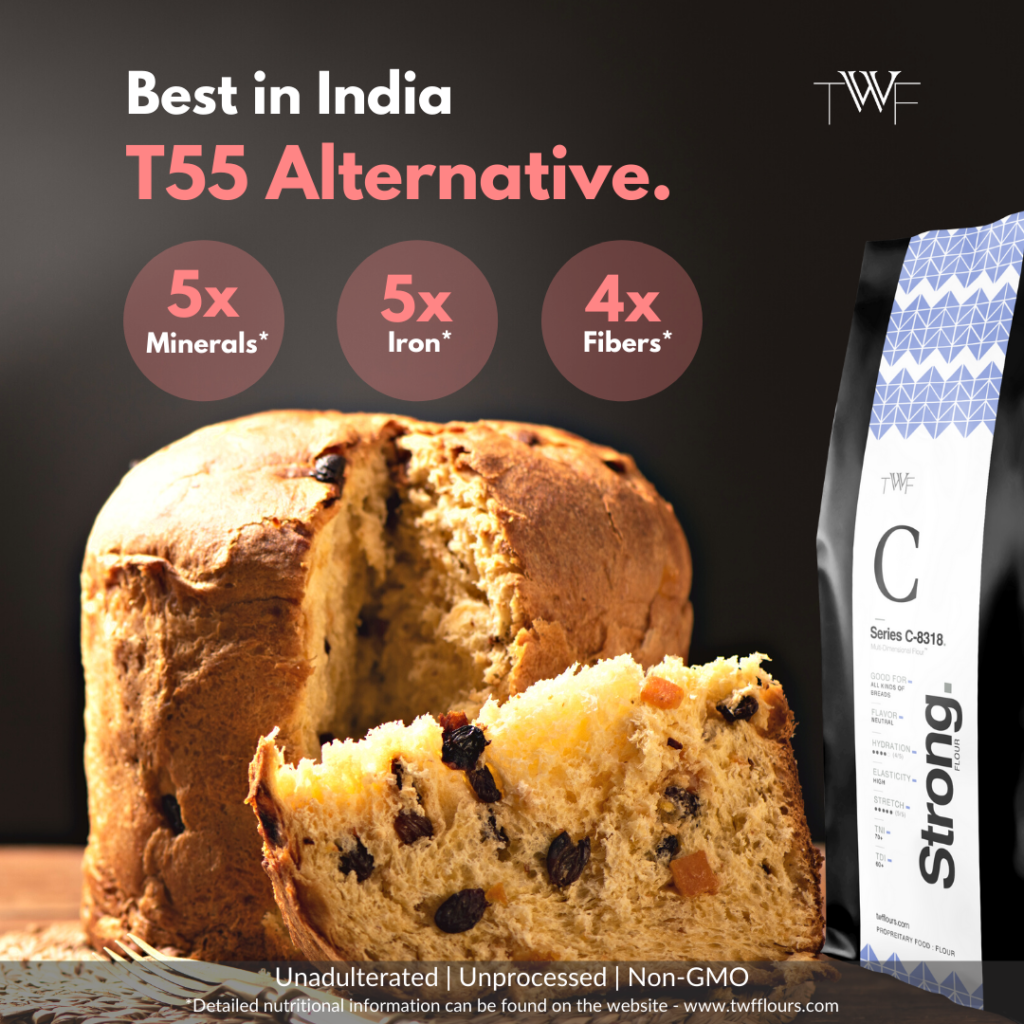Best T55 Alternative in India
“An authentic brioche with about 50% butter (baker’s percentage) is near to impossible to nail with anything other than T55!” This was a fact that bakers did not like. Bakers frequently end up tweaking the recipes. Mostly, reducing butter and eggs quite considerably results in a manageable dough with the Indian flours that are readily available. And this impacts the texture, structure, and overall flavors of the brioche. The cotton light and the golden yellow shreddable crumb with a thin soft crust becomes impossible to achieve. The question remains “What is the best T55 alternative in India?”
The problem is real! For an authentic French enriched loaf whether it is a Brioche or Panettone, using French flour makes all the difference. Although most flours seem similar to naked eyes, they are drastically different from one another, in terms of their behavior, flavor, and final outcome. This is mostly based on – wheat variety, the protein content, the bran content, the region the grain is farmed, the season of harvest, the mill the flour was processed in, the grind (particle size), the grinding technique, and many such factors! And this is why you cannot substitute a particular flour in a recipe with any flour and still expect similar results. Finding the right kind of flour alternative can seem confusing and exhaustive.
Understanding French flours
To be able to make an ‘informed’ choice, a baker must understand the difference between each one and what those flours bring to the table. Typically, French flours are labeled with alpha-numeric names. ‘T’ represents ‘type’. The type number refers to the amount of mineral content in 100g of flour. A precise amount of flour is baked at a very high temperature and the resulting “ash” or mineral content is measured. For example, a Type 55 flour will have between 0.5 and 0.6% of minerals for each 100g of flour. The lower the number, the whiter the flour. The higher the number the more complete or ‘wholemeal’ the flour.
| FRENCH | ITALIAN EQUIVALENT | INDIAN EQUIVALENT | ASH % | PROTEIN % | BEST FOR |
| T45 | 00, 0 | Cake Flour | 0.45 | 9 | Cakes Pastries |
| T55 | 0 | Bread Flour – TWF Series C-8318 | 0.55 | 11-13 | Enriched Breads – Croissants Brioche Babka Panettone |
| T65 | 1 | Bread Flour – TWF Series C-8714 | 0.65 | 13-14 | Artisan Breads- Baguettes Bagels Sourdough breads Pizza |
| T150 | Farina integrale | Bread Flour – TWF Flour X | 1.5 | 12-13 | Whole-grain Breads |
Why use T55 for enriched breads?
When a baker is looking for a flour substitute for a recipe, it is also important to understand the characteristics of the flour and how it contributes to the texture and properties of the bread.
A typical T55 has the following characteristics –
This type of flour is best known for making enriched breads. The flour gives a light open textured loaf with a cotton-light, soft, shreddable crumb and a thin, soft crust. It is high in protein content and has a great balance between elasticity and extensibility. T55 also has phenomenal inclusion tolerance i.e. the dough does not fall apart on the incorporation of high amounts of butter, eggs, and other inclusions like- fruits, chocolates, or nuts.
1. Higher in protein % than wholemeal flour – a greater capacity to trap air bubbles for the tall structure.
2. Finer than refined flour/APF/maida – provides the classic soft shredded crumb
3. High elasticity and extensibility – easily manageable dough
4. Higher inclusion tolerance – withstands the high proportions of butter, eggs, and other inclusions without compromising the rise and texture
What is the best T55 alternative in India?
So, circling back to the question, “What is the best T55 alternative in India?”
TWF’s Series C-8318 is the best T55 equivalent in India, that is unadulterated, unbleached, and uncompromised.
TWF’s Series C-8318 is a high-protein, purpose-crafted flour for enriched breads. C-8318 is Multi-Dimensionally Milled™ to create a superior protein-starch construct. It enables easy dough development, exceptional crumb structure, and rise. This intelligent construct also enables the gluten-starch networks to accommodate very high amounts of fats and inclusions without aid from chemicals or added gluten (Fig. 1).

(Source – www.twfflours.com)
The flour intelligently blends wheat strains to create a dynamic protein profile that results in a lofty enriched bread with an incredible crumb structure. Multi-Dimensionally Milled™ renders 56% higher perceived protein to C-8318. While the measured protein of C-8318 is around 12.4-13%, its perceived protein is 14% i.e. it behaves like flour with 14% protein. Perceived protein measures the potential of flour to make a functional gluten network. Gluten is formed when two of wheat’s native proteins, glutenin, and gliadin, come into contact with water. A higher measured protein percentage does not mean higher gluten-forming potential in the dough. Perceived protein is a measure of the strength of the flour and is a much more accurate barometer for bread bakers than the flour’s protein content.

Find the recipe for the brioche bread with Series C-8318 on TWF’s online community DOUGH.
TWF’s Series C-8318 is nutritionally superior to T55
Although, C-8318 is touted as an Indian equivalent to T55, it in fact nutritionally superior. Multi-Dimensionally Milled™ C-8318 is made from carefully curated wheat strains and milled with precision to retain optimum nutrition (Fig.3). The novel milling technique allows the retention of bran and germ without interfering with the flour’s functional properties. Multi-Dimensionally Milling™ also provides granular control over the flour – how your flour behaves at each stage of kneading, resting, and baking.

Unlike most bread flours, Series C-8318 does not have any chemicals, preservatives, improvers, or added vital gluten. It is a blend of carefully curated Indian wheat strains and milled Multi-dimensionally to accentuate the functionality of the flour without depending on any additives (Table 2).
| PROPERTIES | T55 | Maida | Series C-8318 |
| Rich in micro-nutrients – vitamins and minerals | No | No | Yes – 80% more micro-nutrients* |
| High fiber content | No | No | Yes – 4x more fibers* |
| Unbleached | May be | No | Yes |
| Added vital gluten | Yes | Yes | No |
| Conditioners/ Improvers | Yes | May be | No |
How to replace T55 with Series C-8318 in a recipe?
Series C-8318 can be replaced in recipes calling for T55/maida at a 1:1 ratio. For best results, the following tweaks or customizations are suggested –
- Autolyse – Accommodate an autolyze step of at least 40 minutes for best results with C-8318.
- Easier dough development – Rigorous kneading or slap and folds might not be required to strengthen the dough. C-8318 is Multi-Dimensional™ and harbors intelligent interactions between starch and gluten. This makes the flour more forgiving and easier to develop.
- Crafted for enriched breads– C-8318 is crafted for enriched breads which bake at 180-200C within 20-30 minutes. It browns faster at temperatures above 200C. For recipes that call for baking longer and/or at higher temperatures, you can avoid over-browning by tenting the baking tin with aluminum foil.
- TWF Series C-8318 has high inclusion tolerance – Multi-Dimensional™ 8318 is crafted to house plenty of inclusions and fats without compromising crumb structure. So, you can comfortably add inclusions without the worry of dough breaking down.
- Incorporate water into the dough in installments, if your recipe calls for hydration above 70% – Multi-Dimensional™ 8318 has natural starch-gluten networks that absorb the water and require time to re-align. Adding water a little at a time gives the dough time to accommodate the additional hydration.
For more information on Series C-8714 or To place an order, the website.


Responses